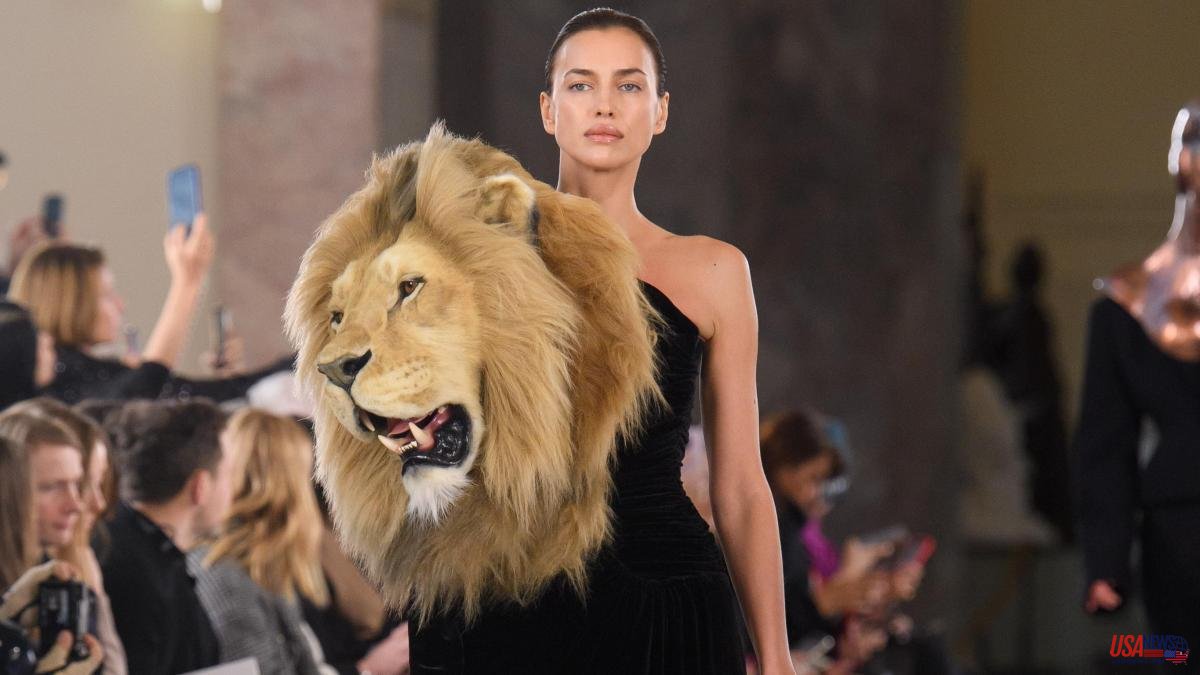Haute couture shows have become explosions of ephemeral art that bring together multidisciplinary creators to elevate costumes on the catwalk. This has been demonstrated by the Parisian Haute Couture Week that has just been held in such emblematic places as the Musée Rodin (Dior) or the Grand Palais Ephémère (Chanel). It is not only about exclusive clothes designed by the couturiers accompanied by their legion of petits mains – that already anachronistic diminutive to refer to the most qualified seamstresses – but a true feast for the senses. Artists and designers seal a pact of convenience thanks to the generous budgets of the maisons, today powerful holding companies convinced that there is no more sublime loudspeaker than haute couture, where creativity has an open bar.
The sequence is brief, in less than twenty minutes three sensations must be concentrated: astonishment, virtuosity and paradox. The best sellers are not worth it, the easy prose. "Haute couture is what remains when everything else has been forgotten." The phrase is signed by Jean-Paul Gaultier and Haider Ackerman. That is the ambition. That we continue talking about it as we do about that New-look that brought color back to the streets after the Second World War, or Schiaparelli's shocking color, inspired by the begonias in his Roman garden. The parade format invented by Charles Worth for Eugenia de Montijo today reaches the category of stage art. Literature, music and fine arts join forces to conspire against the aesthetic topic. Because the history of humanity could also be read as that of a tireless fight against ugliness. And, in it, the noble couture has needed powerful allies in all artistic movements.
"Beauty will be convulsed or it will not be" defended Elsa Schiaparelli. And Daniel Roseberry, an American in Paris in charge of his maison, follows the motto. He explained that his collection consisted of a tribute to “the doubt of creation and the doubt of intention. The parallel -sometimes contradictory- impulses to please the public and to impress oneself. The couturier resorted to Dante's Divine Comedy and wanted to interpret the passage through infernal circles.
Wild beasts emerge from that dark forest, their heads clinging to the body in a dramatization of the jewel. When the model Irina Shayk walked down the catwalk dressed in a suit with the face of a lion on the chest, the networks burned indignant: "Isn't this glamorizing big game?" It was a fake taxidermy made of resin, Faux fur and wool, hand-painted, more stuffed animal than trophy. For Roseberry, this blurring of the border between the real and the unreal is her surreal way of understanding the present through deliberate artifice. And of creating conversation. Or it's not the luxury brands today that are great generators of content Rosberry concluded, haute couture is the fuel of fashion, it is “making culture”.
Bernard Arnault, the chairman of LVMH and the world's richest man, announced Thursday that the reopening of the Chinese market "augurs an extremely strong start to 2023." The biggest driver of luxury value in the world, he is a huge art collector, as is his competitor, Françoise Pinault. Both have ambitious foundations and promote the intervention of artists and philosophers in their firms such as Yayoi Kusama with Louis Vuitton and Paul Preciado with Gucci.
Last Tuesday the parade of its flagship, Dior, was held, which has tripled its turnover with a feminist discourse, a profusion of logos and an alliance with prized contemporary artists. On this occasion, Maria Grazia Chiuri had Mickalene Thomas, in charge of making 13 portraits that embodied female black power. The faces of Nina Simone or Josephine Baker guarded a catwalk that inhaled the smoke of jazz. And Chiuri paid tribute to that slave from Missouri who triumphed in the Follie Bergères; the vedette-spy who danced and laughed like nobody else. Baker was a client of the Dior house, establishing a carefree way of wearing luxury clothes, and even walked the Champs Elysees with her Chiquita panther.
Redeemed nostalgia, invocation of animals and cult of the legacy have been three constants of this edition. Virginie Viard, at the head of Chanel, still with a measured low profile after succeeding the almighty Lagerfeld, closes the bond with the painter and sculptor Xavier Veilhan. The cultural legacy of the firm does not admit truce. On this occasion, Viard asked him to reinterpret Gabrielle Chanel's bestiary, and the result was the abstraction of eleven huge animals made of wood, cardboard and paper that the models hid inside. Viard wanted to recreate a certain party air, for which she used different uniform codes and even appealed to “majorette poetry”, quite a challenge.
A redouble of virtuosity was produced in the Jean-Paul Gaultier show, led by Haider Hackerman, who was the eternal successor of the greats -always supported by his muse, Tilda Swinton-, emerged like a phoenix, offering an authentic recital of true fashion: the spectacle resided in the layout of the tailoring of the archives, in the brilliance of the garments. The soundtrack threw “For” as a song to freedom -the theme dedicated to the young Iranian Mahsa Amini-murdered for wearing the veil poorly- for which her composer, Shervin Hajipour, was imprisoned. It was a reaffirmation that fashion is also political.
Juana Martín, the only Spaniard who parades in haute couture -after meeting the strict conditions required by the Parisian union chamber- presented the Origins collection, where in addition to reinterpreting a South beyond clichés, with a commitment to networked crystals , creating surprising meshes. From Paris, the gypsy creator assures La Vanguardia: “For me, fashion is art, it is its full expression, I cannot conceive of fashion without art. They go hand in hand. In this collection, we have handcrafted the stamping and each piece has an architectural vision”.
And what will become of the fanciful garments that paraded? We will see some of them on the red carpets, others will be bought by collectors –luxury is an investment-, and a few will belong to the 1% of women on the planet. privileged? There will be those that will only exhibit them in private, because in public they must be covered. Museums will be the final destination of the best pieces, understood as an expression of an era, once the artistic value has overcome the main condition of fashion: its ephemeral nature.













